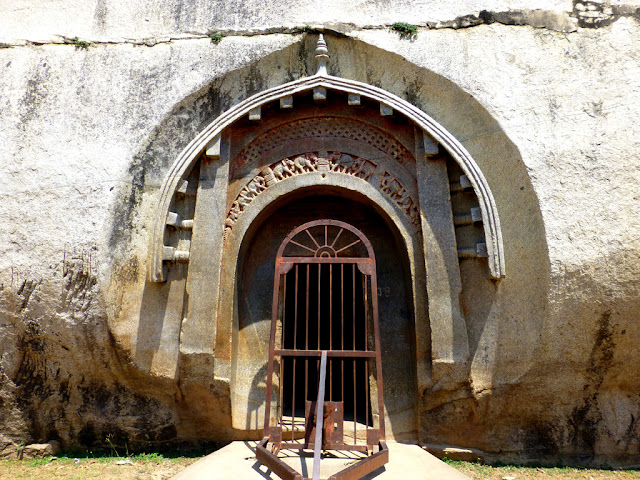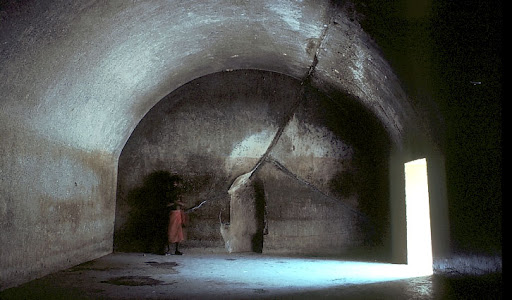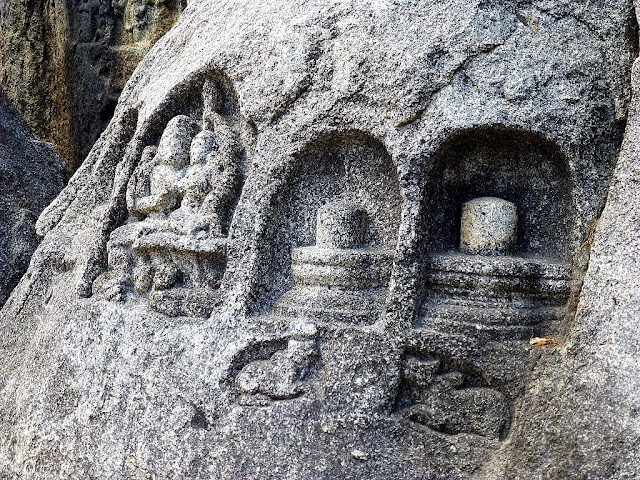ASOKA, AND THE BEGINNINGS OF THE BUDDHIST SCHOOL (cir. B.C. 250)
The efforts of the Ashokan, sculptors were not, however, directed entirely to the production of religious monuments, as these craftsmen were also employed in the preparation of some of the most important parts of the Mauryan emperor’s palace.
This appears to have been a very remarkable conception so much so that it had the legendary reputation of being not the work of man but having been magically raised by Yakshas or supernatural beings.
As late as the visit of Fa-Hien this traveler was so impressed that he states it was “made by spirits who piled up the stones, reared the walls and gates, and executed the elegant carving and inlaid sculpture work in a way which no human hands of this world could accomplish”.
Shortly after the pilgrim’s visit, having been in existence for over six hundred years it seems to have been almost entirely destroyed by fire, so that the only material records of its design and character have been obtained by excavation, wherein the silt of Kumrahar, a site to the south of the present city of Patna, its ashes have remained for fifteen hundred years.
Suggested: Prehistoric Rock Art of Africa
From these investigations the palace appears to have been an aggregation of structures enclosed within a high brick wall, the most important of which was an immense pillared hall in three stories on a high stylobate and covering a square of two hundred and fifty feet side.
The columns which supported the roof were probably in rows of fifteen with fifteen pillars in each row, set al distances of fifteen feet from each other, center to center, making a total of two hundred and twenty-five pillars in all.
The ceiling of one of the stories may have been supported by colossal stone caryatid figures as traces of these have been discovered within the bays formed by the pillars.
Little more than fragments remain of the stonework used in the palace but the polish on most of them indicates that a good deal of this was used in its construction, and for a variety of purposes.
Suggested: Impressionism: A Revolutionary Art Movement
It is fairly certain that all the pillars of the hypostyle hall were of stone as the numerous broken portions testify, while one example has been discovered almost complete, a highly polished cylindrical shaft tapering like a pine trunk some twenty inches in diameter at its base, and when entire about twenty feet in height without any signs of a base or capital.
On this pillar was inscribed a mason’s mark similar in many respects to a symbol used in the rock- carving at Behistun in Persia.
The wide intercolumniation of the pillars shows that they must have supported wooden beams and in fact much of the building appears to have consisted of wood, hence its destruction by fire.
From these remains it has been deduced that the arrangements of Asoka’s palace at Pataliputra was inspired to some extent by those of the Achaemenids and that the grouping of the buildings within a walled enclosure corresponds in some respects to the complex of palaces at Persepolis, the pillared hall being in close agreement with the Hall of a Hundred Columns built by Xerxes.
The mason’s mark on the pillar seems to confirm the fact that Persians or Medes were employed in some of the work, and that the idea of the colossal supporting figures, or atlantes, bears some relation to the bas-reliefs representing figures supporting upper stories on their upraised arms in the tomb of Darius at Nakshi-i Rustam and the Throne Room at Persepolis.
Although only a few pieces of figures presumed to be Atlantean have been recovered at Pataliputra, that the Mauryan craftsmen knew how to produce statues of heroic size is proved by several of these having been found in various parts of the country, including two large and sculpturesque Yakshas or chauri (fly-whisk) bearers excavated near Patna.
Suggested: Greek architecture
It was probably figures of this kind that supported the wooden roof of Asoka’s palace, for one of the upright bars of the Barhut gateway, executed at a slightly later date, displays a small model of a figure-pillar which has every appearance of having been copied from some traditional! type.
Atlantes and caryatid supports, as for instance the dwarf capital on the Sanchi gateway, and the pillar of the chankrama or sacred promenade at BudhGaya, besides many later examples, all show that pillars of a similar nature were a favorite architectural device with the Indian builder.
As to the facade of Asoka’s palace, some idea of this may be gained from a carved stone in the Mathura Museum, possibly dating from the first century A.D.
It depicts the frontage of an important building in two or more stories, each storey formed of a continuous arcade of horseshoe archways with bays between.
Each bay contains a hanging balcony supported on a pillar and the central doorway of the whole is evidently part of a large projecting portico.
Differing widely in intention from the foregoing, but, as the technical treatment of the carving and the enamel-like polish of all the surfaces testifies, evidently belonging to the same school, are the rock-cut sanctuaries in the hills about nineteen miles north of Gaya.
In all, there are seven of these chambers, four on the Barabar hill and three on the Nagarjuni hill half a mile north-east. In addition, there is another example called the Sitamarhi situated some thirteen miles south of Rajgriha and twenty-five miles east of Gaya.
The two first-named groups have been quarried with infinite labor out of the large boulder-like masses of quartos gneiss which forms this range, a site evidently selected as an ideal retreat amidst pleasant, although wild surroundings.
They contain several inscriptions from which it is seen that they were prepared to the order of the Emperor Asoka for the use of certain Ajivika ascetics, followers of a sect that was not Buddhistic but related to the Jaina religion.
These chambers have two special interests as on the one hand, they are the earliest examples in India of the rock-cut method, and on the other, some of them are exact copies in the rock of existing structures in wood and thatch.
Suggested: Essential tools and materials for painting
The interiors of some of the cells have been extracted so to speak, from their rock-bed and reconstructed in order to illustrate the kind of building they were supposed to imitate.
The two most notable, the Lomas Rishi and the Sudama have been cut adjacent to one another on the Barabar hill, and their interiors are very similar, while the former is exceptional as it is the only one which has an ornamental facade.
From the sectional drawing of the Sudama the interior arrangements may be understood.
The doorways, notable for their sloping jambs, of both Sudama and Lomas Rishi are in the long side of the chamber, clearly an expedient due to the configuration of the whale-backed hill which prevented the excavation being made axially.
Inside is a barrel-vaulted hall 32 ft. 9 ins. by 19 ft. 6 ins. and 12 fi. 3 ins. in height. At the end of the ante-chamber and entered by a central interior doorway is a separate circular cell 19 ft.
In diameter with a hemispherical domed roof 12 ft. 3 ins. high at its center. Exteriorly this cell has an overhanging eave like a thatch and, most singular of all, its walls have irregular perpendicular grooves in imitation of upright battens of wood or bamboo.
In a word it is an exact lithic copy of a beehive hut, and almost every part of the surface has been burnished until it resembles glass.
Remarkable though these interiors are, the facade which surrounds the doorway of Lomas Rishi is the chef-d’ceuvre of the group, as it is an accurate reproduction of the gable end of a wooden structure chiseled in the rock-face.
The stone-cutter has copied in every detail the handiwork of the carpenter. Two stout uprights inclined slightly inwards and some 13 ft.
In height from the main support while into the upper ends of these are jointed the two principal rafters, other subsidiary rafters lying parallel.
On the rafters is fixed the curved roof composed of three laminated planks, the lower extremities of which are kept in place by short tie-rods, circular in section, and obviously turned on a lathe.
The doorway, some 7 ½ feet high, is recessed within a semi-circular archway above which are two lunettes forming a kind of fanlight.
In the lower lunette is carved a procession of elephants, while the upper is filled with a diaper pattern of lattice-work, both designs evidently being copies of perforated wood.
The elephants are exquisitely modeled and are performing an obeisance before stupas which are introduced into the lunette as solid supports to the openwork.
Surmounting the gable is a filial which by its shape is derived from a terra cotta original; every detail of the facade is sharply chiseled and each part still retains its high polish, the whole except for a few fractures looking as if it had been cut but yesterday.
CONTINUE READING: ASOKA, AND THE BEGINNINGS OF THE BUDDHIST SCHOOL -4

















